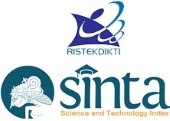Destination Website Quality dan Online Destination Brand Experience: Studi Pada Kota Tua Jakarta dan Kepulauan Seribu
Abstract
ABSTRACT
This research aims to determine and analyze the influence of destination website quality, sensory online destination brand experience, cognitive online destination brand experience, attitude toward the website and intention to visit which are applied to the tourist website of Kota Tua Jakarta and the Thousand Islands. This research uses a quantitative approach using primary data collected from August to October 2023. Questionnaires were distributed to visitors to the Kota Tua Jakarta and Thousand Islands tourist website. 221 questionnaires data can be collected and then processed using Structural Equation Modeling with SmartPLS software. The results of data processing show that not all hypotheses can be accepted. Several suggestions are given for developing further studies and developing website management strategies to achieve increased tourist visits to the Kota Tua Jakarta and the Thousand Islands.
ABSTRAK
Penelitian ini bertujuan untuk mengetahui dan menganalisis pengaruh variabel destination website quality, sensory online destination brand experience, cognitive online destination brand experience, attitude toward the website, dan intention to visit yang diaplikasikan pada website wisata Kota Tua Jakarta dan Kepulauan Seribu. Penelitian ini menggunakan pendekatan kuantitatif menggunakan data primer berupa kuesioner yang dikumpulkan selama bulan Agustus sampai dengan Oktober 2023. Kuesioner disebarkan kepada pengunjung website wisata Kota Tua Jakarta dan Kepulauan Seribu. Sebanyak 221 data kuesioner dapat dikumpulkan dan kemudian diolah lebih lanjut menggunakan Structural Equation Modelling dengan memanfaatkan software SmartPLS. Hasil olah data menunjukkan bahwa tidak seluruh hipotesis dapat diterima. Beberapa saran diberikan untuk pengembangan studi lebih lanjut serta pengembangan strategi pengelolaan website demi mencapai peningkatan kunjungan wisata ke Kota Tua Jakarta dan Kepulauan Seribu.
Keywords
Full Text:
PDFReferences
Ayu, J. P., Octavanny, V., Hutagaol, O., & Simanjuntak, M. B. (2023). Learning experience concept at Museum Gedung Juang 45 Bekasi Regency as a digital museum. JITHOR, 6(2).
Bai, B., Law, R., & Wen, I. (2008). The impact of website quality on customer satisfaction and purchase intentions: Evidence from Chinese online visitors. International Journal of Hospitality Management, 27(3), 391–402.
Barnes, S. J., Mattsson, J., & Sørensen, F. (2014). Destination brand experience and visitor behavior: Testing a scale in the tourism context. Annals of Tourism Research, 48, 121–139.
Boo, S., & Kim, M. (2019). Tourists’ online reviews of convention centers. Journal of Convention & Event Tourism, 20(2), 135–162.
Brakus, J. J., Schmitt, B. H., & Zarantonello, L. (2009). Brand experience: What is it? How is it measured? Does it affect loyalty? Journal of Marketing, 73(3), 52–68.
Brochado, A., Troilo, M., Rodrigues, H., & Oliveira-Brochado, F. (2019). Dimensions of wine hotel experiences shared online. International Journal of Wine Business Research, 32(1), 59–77.
Bruner, G. C., & and Kumar, A. (2005). Explaining consumer acceptance of handheld internet devices. Journal of Business Research, 58(3), 553–558.
Bustamante, J. C., & Rubio, N. (2017). Measuring customer experience in physical retail environments. Journal of Service Management, 28(5), 884–913.
Carù, A., University, B., & Cova, I. B. (2003). Revisiting consumption experience a more humble but complete view of the concept. Marketing Theory, 3(2), 267–286.
Chen, Q., & Wells, W. D. (1999). Attitude toward the site. Journal of Advertising Research, 39(5), 27–37.
Davis, L., Wang, S., & Lindridge, A. (2008). Culture influences on emotional responses to on-line store atmospheric cues. Journal of Business Research, 61(8), 806–812.
Fornell, C., & Bookstein, F. L. (1982). Two structural equation models: LISREL and PLS applied to consumer exit-voice theory. Journal of Marketing Research, 19(4), 440–452.
Haddouche, H. (2018). Generation Z and the tourist experience: tourist stories and use of social networks. Journal of Tourism Futures, 4(1), 69–79.
Hair, J. F., Ringle, C. M., & Sarstedt, M. (2011). PLS-SEM: Indeed a silver bullet. Journal of Marketing Theory and Practice, 19(2), 139–152.
Henseler, J., & Sarstedt, M. (2013). Goodness-of-fit indices for partial least squares path modeling. Computational Statistics, 28(2), 565–580.
Hudson, S., & Ritchie, J. R. B. (2009). Branding a memorable destination experience. The case of “Brand Canada.” International Journal of Tourism Research, 11(2), 217–228.
Hwang, J., & Kim, J.-Y. (2020). Food tourists’ connectivity through the 5A journey and advocacy: Comparison between generations Y and X. Asia Pacific Journal of Tourism Research, 25(1), 27–38.
Jiménez Barreto, J., Rubio, N., & Campo Martínez, S. (2019). The online destination brand experience: Development of a sensorial–cognitive–conative model. International Journal of Tourism Research, 21(2), 245–258.
Jiménez-Barreto, J., Sthapit, E., Rubio, N., & Campo, S. (2019). Exploring the dimensions of online destination brand experience: Spanish and North American tourists’ perspectives. Tourism Management Perspectives, 31, 348–360.
Koo, D. M., & Lee, J. H. (2011). Inter-relationships among dominance, energetic and tense arousal, and pleasure, and differences in their impacts under online vs. offline environment. Computers in Human Behavior, 27(5), 1740–1750.
Kumar, V., & Kaushik, A. K. (2018). Destination brand experience and visitor behavior: the mediating role of destination brand identification. Journal of Travel and Tourism Marketing, 35(5), 649–663.
Lee, S., & Jeong, M. (2014). Enhancing online brand experiences: An application of congruity theory. International Journal of Hospitality Management, 40, 49–58.
Lee, W., & Gretzel, U. (2012). Designing persuasive destination websites: A mental imagery processing perspective. Tourism Management, 33(5), 1270–1280.
Lee, W., Gretzel, U., & Law, R. (2010). Quasi-trial experiences through sensory information on destination web sites. Journal of Travel Research, 49(3), 310–322.
Li, X., Li, X., & Hudson, S. (2013). The application of generational theory to tourism consumer behavior: An American perspective. Tourism Management, 37, 147–164.
Loureiro, S. M. C. (2015). The role of website quality on PAD, attitude and intentions to visit and recommend island destination. International Journal of Tourism Research, 17(6), 545–554.
Loureiro, S. M. C., & Kastenholz, E. (2011). Corporate reputation, satisfaction, delight, and loyalty towards rural lodging units in Portugal. International Journal of Hospitality Management, 30(3), 575–583.
Luna-Nevarez, C., & Hyman, M. R. (2012). Common practices in destination website design. Journal of Destination Marketing and Management, 1(1–2), 94–106.
Martins, H., Carvalho, P., & Almeida, N. (2023). Destination brand experience and place attachment. Tourism, 71(1), 106–120.
Masiero, L., Viglia, G., & Nieto-Garcia, M. (2020). Strategic consumer behavior in online hotel booking. Annals of Tourism Research, 83.
Maulina, A., Budiarti, R., Ruslan, B., & Rahmawati, N. F. (2022). The influence of perceived price on revisit intention through social influence for adaptive reuse Building in the Old City of Jakarta. Jlomata International Journal of Social Science, 3(4), 367–376.
Maulina, A., Ruslan, B., Ekasari, R., Tinggi, S., & Bagasasi, I. A. (2022). How Experience Quality, Prior Knowledge and Perceived Value Affect Revisit Intention to Batavia Jakarta. Majalah Ilmiah Bijak, 19(2), 158-167.
Maulina, A., Sukoco, I., Hermanto, B., & Kostini, N. (2023). Tourists’ revisit intention and electronic word-of-mouth at adaptive reuse building in Batavia Jakarta heritage. Sustainability (Switzerland), 15(19).
Maulina, A., Waskito, R. A., & Ruslan, B. (2022). Pengaruh harga yang dirasakan terhadap minat kunjungan berulang melalui nilai yang dirasakan pada bangunan berkonsep penggunaan kembali di kawasan Kota Tua Jakarta. Journal of Indonesian, Tourism, Hospitality and Recreation, 5(2), 219–228.
Mazaheri, E., Richard, M. O., & Laroche, M. (2011). Online consumer behavior: Comparing Canadian and Chinese website visitors. Journal of Business Research, 64(9), 958–965.
Morgan, N. J., Pritchard, A., & Piggott, R. (2003). Destination branding and the role of the stakeholders: The case of New Zealand. Journal of Vacation Marketing, 9(3), 285–299.
Morgan-Thomas, A., & Veloutsou, C. (2013). Beyond technology acceptance: Brand relationships and online brand experience. Journal of Business Research, 66(1), 21–27.
Parasuraman, A., & Grewal, D. (2000). The impact of technology on the quality-value-loyalty chain: A research agenda. Journal of the Academy of Marketing Science, 28(1), 168–174.
Park, Y. A., Gretzel, U., & Sirakaya-Turk, E. (2007). Measuring Web Site Quality for Online Travel Agencies. Journal of Travel & Tourism Marketing, 23(1), 15-30.
Parrott, G., Danbury, A., & Kanthavanich, P. (2015). Online behaviour of luxury fashion brand advocates. Journal of Fashion Marketing and Management, 19(4), 360–383.
Pranić, L., Praničević, D. G., & Arnerić, J. (2014). Hotel website performance: evidence from a transition country. In Tourism and Hospitality Management, 20(1), 45-60.
Riyanto, W., Rahmanita, M., & Wulan, S. (2023). Museum Gastronomi Indonesia virtual sebagai destinasi wisata edukasi, sejarah dan hiburan Sekolah Tinggi Pariwisata Trisakti, Indonesia. JITHOR, 6(1).
Robinson, V. M., & Schänzel, H. A. (2019). A tourism inflex: Generation Z travel experiences. Journal of Tourism Futures, 5(2), 127–141.
Rodríguez-Fernández, M.-M., Sánchez-Amboage, E., & Juanatey-Boga, O. (2019). Virtual tourist communities and online travel communities. In Studies in Systems, Decision and Control, 154, 435–446. Springer International Publishing.
Rose, S., Clark, M., Samouel, P., & Hair, N. (2012). Online customer experience in e-retailing: An empirical model of antecedents and outcomes. Journal of Retailing, 88(2), 308–322.
Scharlr, A., Wober, K. W., & Bauer, C. (2008). An integrated approach to measure web site effectiveness in the European hotel industry. Information Technology & Tourism, 6(4), 257–271.
Uriely, N. (2005). The tourist experience conceptual developments. Annals of Tourism Research, 32(1), 199–216.
Verhoef, P. C., Lemon, K. N., Parasuraman, A., Roggeveen, A., Tsiros, M., & Schlesinger, L. A. (2009). Customer experience creation: Determinants, dynamics and management strategies. Journal of Retailing, 85(1), 31–41.
Voorveld, H. A. M., Neijens, P. C., & Smit, E. G. (2009). Consumers’ responses to brand websites: an interdisciplinary review. Internet Research, 19(5), 535–565.
Wongpan, S., & Khamwon, A. (2016). Destination brand experience, satisfaction, and behavioral intention: Evidence from Mice Khon Kaen. In Conference of the International Journal of Arts & Sciences, 6114(09), 01.
Wu, G. (2005). The mediating role of perceived interactivity in the effect of actual interactivity on attitude toward the website. Journal of Interactive Advertising, 5(2), 29–39.
Yoon, D., & Youn, S. (2016). Brand experience on the website: Its mediating role between perceived interactivity and relationship quality. Journal of Interactive Advertising, 16(1), 1–15.
Zarantonello, L., & Schmitt, B. H. (2010). Using the brand experience scale to profile consumers and predict consumer behaviour. Journal of Brand Management, 17(7), 532–540.
DOI: https://doi.org/10.17509/jithor.v7i1.64100
Refbacks
- There are currently no refbacks.

This work is licensed under a Creative Commons Attribution-ShareAlike 4.0 International License.
eISSN : 2654-4687
pISSN : 2654-3893
This work is licensed under Creative Commons Attribution-ShareAlike 4.0 International License















